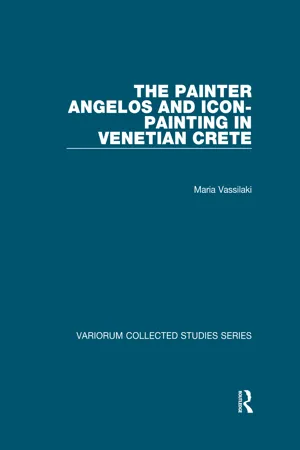
- 382 pages
- English
- ePUB (mobile friendly)
- Available on iOS & Android
The Painter Angelos and Icon-Painting in Venetian Crete
About This Book
The sixteen studies in this book include six specially translated from Greek and another two published here for the first time. They deal with the art of painting in Crete at a time when the island was under Venetian rule. The main emphasis is on the 15th century and especially on the painter Angelos. More than thirty icons with his signature survive, and at least twenty more can be reliably attributed to him. Angelos was the most significant artist of a particularly significant era. It was at this time that the centre of artistic production migrated from Constantinople, the capital of the Byzantine Empire to Candia, the capital of Venetian-occupied Crete. These studies try to reconstruct the personality of this late Byzantine painter, Angelos, not only through his icons but also through his will (1436), now in the State Archives in Venice. In this context they also explore the status of the Cretan painter in society. The large number of extant Cretan icons clearly indicates the striking increase in production from the 15th century onwards. Similarly, archival documents are used to examine the trade of icons in Crete and the way Cretan artists had to organize their workshops in order to meet the requirements of the market.
Frequently asked questions
Table of contents
- Cover
- Half Title Page
- Title Page
- Copyright Page
- Contents
- Introduction
- Acknowledgements
- List of Abbreviations
- Part One: The Painter Angelos
- 1 The Painter Angelos Akotantos: His work and His Will (1436)
- 2 New Evidence on the Painter Angelos Akotantos
- 3 From the ‘Anonymous’ Byzantine Artist to the ‘Eponymous’ Cretan Painter of the Fifteenth Century
- 4 Painting and Painters in Venetian Crete
- 5 St Phanourios: Cult and Iconography
- 6 A Cretan Icon in the Ashmolean: The Embrace of Peter and Paul
- 7 A Cretan Icon of St George
- 8 An Icon of St George on Horseback Killing the Dragon by the Painter Angelos: A New Acquisition in the Benaki Museum
- 9 The Hand of Angelos?
- Part Two: On Cretan Painting
- 10 Some Observations on Early Fifteenth-century Painting in Crete
- 11 Some Cretan Icons in the Walters Art Gallery
- 12 The Reconstruction of a Triptych
- 13 An Icon of the Entry into Jerusalem and a Question of Archetypes, Prototypes and Copies in Late and Post-Byzantine Icon-Painting
- Part Three: The Cretan Painter at Work
- 14 The Icon Trade in Fifteenth-century Venetian Crete
- 15 Workshop Practices and Working Drawings of Icon-Painters
- 16 On the Technology of Post-Byzantine Icons
- Epilogue
- Index